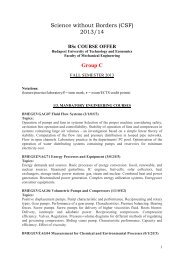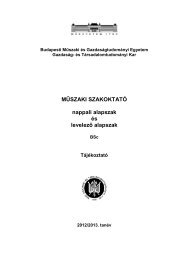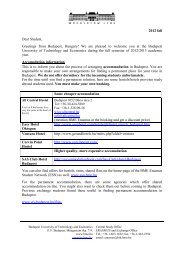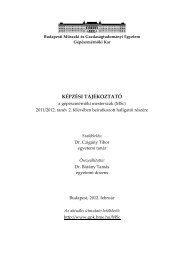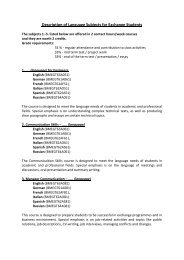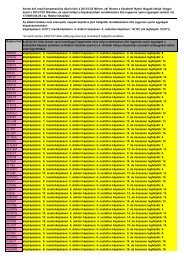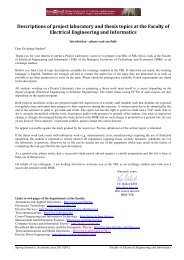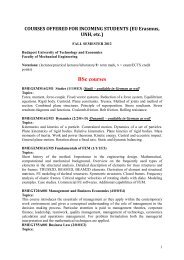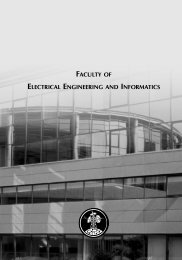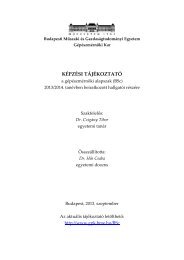BUDAPEST UNIVERSITY <strong>OF</strong> <strong>TECHNOLOGY</strong> <strong>AND</strong> ECONOMICSEconomic Analysis of Technological ProcessesBMEGT30MS07Dr. Dietmar MeyerAfter a short introduction it will be shown how basic categoriescould be described using empiric analysis. This will befollowed by the detailed investigation of the special relationshipbetween technology and costs, again based on empirics.The next block contains questions dealing with the economicconsequences of technological decisions, e. g. exhaustingof natural resources, transport problem, environmental decisions,chosing production places, etc. Finally, problems ofdynamics will be investigated (control of production processes,economic and technological development, etc.)Project Work IBMEVExxM100Design of ExperimentsBMEVEKFM203Dr. Sándor Kemény, Dr. András DeákStatistical intervals. Confidence, tolerance and predictionintervals, their use and interpretation. Error propagation(measurement uncertainty) analysis. Study of error sources ofanalytical measurements according to the EURACHEMGuide. Regression analysis. Parameter estimation using leastsquares for fitting a straight line. Assumptions and checkingtheir validity, adequacy of the function fitted, plotting theresiduals. Methods applied when the variance is not constant(weighted least squares and maximum likelihood). The calibrationproblem:confidence interval for the unknown valueof the independent variable. Multiple linear regression.Nonlinear regression. Analysis of variance: One-wayANOVA, multiple comparisons (contrasts). Assumptions andchecking their validity. Cross-classification. Box-Cox transformation.Advanced ANOVA: random factors, nested design,mixed model, random block. Design of factorial experimentsTwo-level full and fractional designs, Experimental optimisationusing gradient and simplex method. Quadratic designs:3k, Box-Behnken and central composite designs. Statisticalmethods for method validation Repeatability and reproducibility,robustness, linearity. The seminars contain discussionof case studies and solving simpler exercises, students arerequested to solve problems of medium complexity aloneusing statistical software (Statistica).Modern Physics for Chemical EngineersBMETE14MX00Dr. Zoltán NoszticziusElastic waves. transversal and longitudinal wave.Interference. Standing waves. Electromagnetic waves.Electromagnetic field in cavity. Dipole radiation. Polarization.Complex permittivity. Absorption. Diffraction on lattice, diffractionon slit, resolving power, Fresnel-zones, zone lens.Geometric optics as a limit of wave optics. Special relativity.Ether-hypothesis, Michelson-experiment, principle of specialrelativity, Lorentz-transformation. Relativistic dynamics. Restenergy, total energy. Quantum mechanics. Experimentalantecedents. Hamilton's principle, Lagrange-Hamilton-formalism,canonical equations, phase field. Operators, eigenvalues, eigen functions. Heisenberg's commutation rules.Schrödinger's equation. Harmonic oscillator, potential valley,H-atom. Spin. Time dependent Schrödinger's equation.Physical meaning of the state function. Heisenberg's uncertaintyrelations. Tunnel effect. Matter wave, electron microscope.Electric conductivity of the solid states. Super fluidity.Bose-condensation. Compounds of the atomic nucleus.Foundations of transport processes. Field equations.78Substantial time derivative. Density, specific quantity. Localand substantial balance equations. State equations, constitutiveequations. Conservation laws. Balance equations of energy,momentum, electric charge, mass, entropy, chemicalcomponents. Chemical reactions. Balance equation for theinner energy: Fourier's heat conduction. Cross effects.Thermodynamic driving force of the membrane-transport.Convective Nernst-Planck equations in simplified forms.Chemical dynamical systems. Phase field, state vector, trajectory.Nonlinear dynamics and nonlinear chemistry.Conservative and border-line cycles. Dissipative structures.Chemical waves and Turing-machinery.Further detailed information can be found on the department'shome page.Physical Chemistry and Structural ChemistryBMEVEFAM201Dr. Miklós Kubinyi, Dr. András GrofcsikThe concept and characterization of phenomenologicaland statistical thermodynamically systems. The laws of thermodynamics.The transformed functions of internal energyand the chemical potential. Thermodynamics of solutions.Partial molar quantities. Ideal and real solutions.Thermodynamics of phase equilibrium. Homogeneous andheterogeneous chemical equilibrium. Equilibria in electrolytes.Activities and standard states. The Debye-Hückeltheory. Phenomenological and statistical interpretation of therate of reaction. Molecularity and order of reaction.Homogeneous and heterogeneous catalysis, autocatalysis,kinetics of enzyme reactions. Collision theory activated complextheory. Photochemical reactions. Kinetics of reactions insolutions. Characterization of transport processes. Global andlocal balance equations. Thermodynamic driving forces.Thermodynamic driving forces. The laws of diffusion (Fick'sfirst and second law). Laws of unidirectional, radial and cylindricaldiffusion. Microscopic theory of diffusion. Fourier'slaws of heat conduction. Viscosity of liquids and gases.Viscous flow as transport of momentum. Temperaturedependence of viscosity. Newtonian and non-Newtonian liquids.Conductance of electrolytes. Conductivity and molarconductivity. Electrochemical potential. Thermodynamics ofelectrochemical cells. Nernst equation. Types of electrodes.Electrode potentials. Electrode kinetics. Polarization. Laws ofelectrode kinetics. Physical chemistry of biological systems.The following fields of structural chemistry are discussed:Infrared and Raman spectroscopy. Infrared microscope.Electronic spectroscopy: absorption, fluorescence and CDspectroscopy. Study of fast processes with spectroscopicmethods: flash photolysis, time resolved fluorescence.Nuclear magnetic resonance. NMR spectroscopy of solid anddissolved samples. Electron spin resonance. Spin labeling.Mass spectrometry. New ionization techniques: electro spray,MALDI. Structure of condensed phases. Single crystal diffraction,liquid diffraction.Technologies in Organic Chemical IndustryBMEVESZM201Dr. György KeglevichRequirements for the startting materials, solvents, productsand reactions; survey of the organic chemical industry viagreen glasses: dangers, problems and challanges; environmentalfriendly accomplishments in the tenzide-, pesticidefinechemical- and pharmaceutical industry; selection of theappropiate solvent, up-to-date solvents, solvent-free technologies;microwave synthesis as an efficient and selectivemethod, industrial perspectives; transition metal complexesincorporating P-ligands, their use as catalysts, enantioselectivetransformations; solid base and solid acid catalysts, applicationof natural and artificial clays; optimization of reactions;recycling of solvents, utilization of by-products, treatment of
<strong>FACULTY</strong> <strong>OF</strong> <strong>CHEMICAL</strong> <strong>TECHNOLOGY</strong> <strong>AND</strong> BIO<strong>TECHNOLOGY</strong>wastes; development, improvement and change of technologies,examples from the pharmaceutical and fine chemicalindustry.The laboratory practice includes comparison of traditionaland up-to-date technologies, the accomplishment of reactionsin intelligent reactor, monitoring reactions by in situ.Fourier transform IR, realization of reactions in a microwavereactor, optimization of heterogeneous catalytic reactions,application of the ball and tube mill, regulation by the controlledaddition of the reactants, visit to pharmaceutical factoriesto get known up-to-date technologies.Technology ManagementBMEGT20M014Dr. Béla PatakiThe basic concepts of technology management. Life cycletheories: product, technology and factory life cycles. Newtechnologies and the organization. Managing new productdevelopment and product innovation. Implementing newmanufacturing technologies. Auditing technological changeand innovation. IT management. The basics of the strategicmanagement of technology: principles, tasks, typical mistakes.Technology portfolio analysis. Technology roadmapping.Managing core competencies.Environmentally Benign and CatalyticProcessesBMEVEKMF204Dr Béla SimándiNational and international activities with respect to environmentalprograms. "Clean" technologies. EU directives, tendencies,regulations. Clean air projects, activities, processes.Classification of air pollutants, intervention places, exhaustreduction. Water quality control, physico-chemical treatmentof waste waters, WAO, stripping with air or steam. Cleantechnologies, supercritical solvents and processes. Membraneprocesses, case studies. Catalytic processes, working mode ofcatalysts, kinetics, catalyst preparation, testing, modification,catalyst poisons, catalytic reactors, economics of catalyticprocesses. Catalytic processes in environmental technologies,automotive catalysis, fuel-cells, hydrogen and methanoleconomy. At the practices the students get individual tasks,get acquainted with the chosen topic, carry out measurements,evaluate them and finally report about their results inwritten and oral form.Project Work IIBMEVExxM200Biology, BiotechnologyBMEVEMBM301Dr. Andrea Jobbágy1. Introduction, special features of biotech: de novo fermentationsand biotransformations.2. Cell biology summary: cell structure and function3. Microbiology and physiology survey: kinds of industrialmicroorganisms, their biochemistry: aerobes és anaerobes,basic microbial metabolic paths.4. Introduction to enzyme engineering.5. Techniques and unit operations applied in bioindustries:cultivation methods of microorganisms, culture media, sterilization,bioreactors: mass transfer.6. Special methods of product isolation and purification:cell homogenization, affin (biocpecific) methods.7. Some examples in white and green biotechnology:ethanol, citric acid, lactic acid fermentations, etc., biotransformations(semisynthetic antibiotics, enzymatic resolutionmethods)8. Biotechnological waste water treatments:removal oforganic materials, removal of phosphorus and nitrogen.Computational ChemistryBMEVESAM301Dr. Tamás VeszprémiA./ Lecture1./ Basic principles of quantum mechanics: The axioms,the hydrogen atom, the Born-Oppenheimer approximation,the independent particle model, and the MO theory.Hyerarchy of the theoretical models: Molecular mechanics,semiempirical, Hartree-Fock and post HF methods. Oniomand QM-MM methods. Density functional methods. The conceptof the electron density.2./ Application possibilities. Energy and electronic structureof atoms and molecules. Computation of measures relatedto physico-chemical or chemical concepts. Moleculargeometry, conformation, conformational space. Modelingchemical reactions, thermodynamics and transition structures.Large systems, solutions and crystal structures.Molecular dynamics.B./ Practice and problem solving1./ Molecular geometry. Building of molecuéar structuresby program packages. Geometry optimization by molecularmechanics (Isis-draw, Hyperchem and Spartan packages.)2./ Energy-hypersurface and conformational problems(Spartan).3./ Ab initio computations. Basis sets. Molecular Orbitals.Electron density maps. (Spartan package).4./ Computation of molecular and thermodynamic properties(individual molecules, chemical processes in the gasphase, solutions. The use of the Gaussian package.Social and Visual CommunicationBMEGT43MS07Dr. Zsolt Bátori1. Communication theoretical framework2. Image and perception3. Image, society and culture4. The role of pictorial representation in social communication5. The role of photographic representation in social communication6. Communicating in space and with space: the role ofusing space in the course of social communication7. Visual environment and meaning8. The role of design in social communication9. Images and objects as artworks in social communication79



